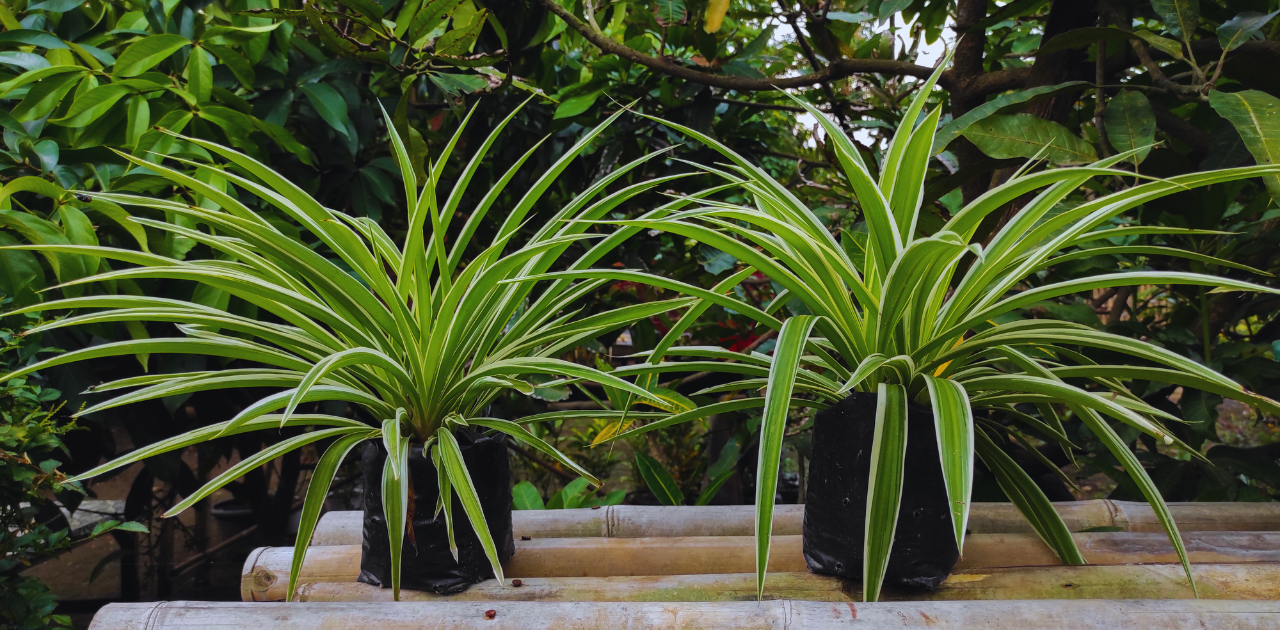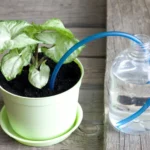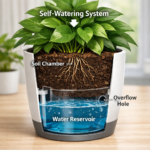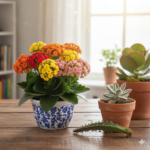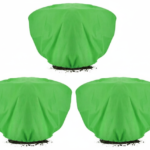The Spider Plant (Chlorophytum comosum) is more than just a decorative addition to your home; it’s a green powerhouse that offers numerous benefits. Renowned for its air-purifying qualities, this resilient plant can remove toxins like formaldehyde and xylene from the air, making your living environment healthier. Beyond its environmental benefits, the Spider Plant is incredibly easy to care for, thriving in various light conditions and requiring minimal attention. Its cascading foliage adds a touch of natural beauty to any room, and its ability to produce “babies” or plantlets makes it a favorite among gardeners who love to propagate and share plants.
Whether you’re a seasoned plant enthusiast or a beginner, the Spider Plant is perfect for enhancing your home’s aesthetic and improving your overall well-being. Every home deserves the beauty and health benefits a Spider Plant can provide.
What is a Spider Plant?

The Spider Plant, scientifically known as Chlorophytum comosum, is a popular houseplant recognized for its easy care and striking appearance. It belongs to the Asparagaceae family, which includes a variety of other well-known ornamental plants.
Scientific Name and Classification
- Scientific Name: Chlorophytum comosum
- Family: Asparagaceae
- Order: Asparagales
- Kingdom: Plantae
Physical Description
The Spider Plant is characterized by its long, slender leaves, typically green with white or yellow variegated stripes. These leaves grow in a rosette pattern and can reach up to 16 inches (40 cm) in length. The plant produces small, white, star-shaped flowers on long, arching stems, which later develop into “siderites” or plantlets—miniature versions of the parent plant. These siderites can be left to cascade down from the plant or easily propagated into new plants.
Native Habitat and Distribution
The Spider Plant is native to the coastal regions of South Africa, where it grows in a variety of environments, including forests and grasslands. Due to its adaptability, it has become naturalized in many other parts of the world. Today, the Spider Plant is widely cultivated as a houseplant in homes and offices globally, prized for its ability to thrive in diverse conditions and its air-purifying qualities.
History of Spider Plants
Origins and Discovery
The Spider Plant (Chlorophytum comosum) has roots in the tropical and subtropical regions of South Africa. It was first discovered in the late 18th century by European botanists exploring the region’s diverse plant life. The plant quickly gained attention due to its resilience and unique appearance, making it a popular choice for European botanical collections and greenhouses.
Popularity Through the Ages
The Spider Plant’s popularity grew steadily throughout the 19th and 20th centuries as it became a favored houseplant in Europe and North America. During the Victorian era, the plant was common in indoor gardens and conservatories. Its ease of care and ability to thrive in various conditions made it accessible to a broad audience, from the wealthy to the working class. In the 1970s, the Spider Plant became a symbol of the growing indoor gardening trend, particularly as an air-purifying plant, leading to its widespread use in homes and offices. Today, it remains a beloved and enduring choice for plant enthusiasts worldwide.
Types of Spider Plants

Common Varieties
- Variegatum: The most popular variety, featuring green leaves with white edges. It’s often seen in homes and offices due to its striking appearance and ease of care.
- Vittatum: This variety is known for its green leaves with a broad, white stripe down the center. It is similar in care to Variegatum but has a slightly different look.
- Bonnie: A curly-leafed variety of the Spider Plant. Its leaves twist and curl, giving it a unique and playful appearance compared to the more straight-leaved varieties.
- Hawaiian: Also known as Chlorophytum comosum ‘Hawaiian’, this variety features smaller, compact leaves with a green and white variegated pattern and is known for its lush appearance.
Unique Characteristics of Each Type
- Variegatum: Known for its resilience and striking variegated leaves, this variety is a favorite for its ability to adapt to various environments while maintaining its vibrant color contrast.
- Vittatum: This type is celebrated for its broad central stripe, which creates a bold visual effect. It’s often used in design settings where a more dramatic foliage pattern is desired.
- Bonnie: The curly foliage of the Bonnie variety adds a whimsical touch to indoor spaces, making it a great choice for those who want something different from the traditional Spider Plant look.
- Hawaiian: The compact and lush growth of the Hawaiian variety makes it ideal for smaller spaces or those who prefer a more dense and bushy appearance.
Importance of the Spider Plant
The Spider Plant (Chlorophytum comosum) holds significant importance as a decorative houseplant and for its numerous health and environmental benefits. Here’s why this plant is a valuable addition to any space:
- Air Purification: One of the most celebrated benefits of the Spider Plant is its ability to purify indoor air. According to studies, including NASA’s Clean Air Study, Spider Plants can effectively remove harmful toxins like formaldehyde, carbon monoxide, and xylene from the air, improving overall air quality.
- Low Maintenance: The Spider Plant is incredibly easy to care for, making it ideal for novice and experienced plant owners. It requires minimal attention and thrives in various lighting conditions with infrequent watering.
- Aesthetic Appeal: The Spider Plant adds beauty to any room with its graceful, arching leaves and vibrant green and white stripes. When grown in hanging baskets, its cascading spiderettes can create a visually pleasing, cascading effect.
- Stress Reduction: Like many indoor plants, the presence of Spider Plants can contribute to a calming environment, helping to reduce stress and promote a sense of well-being.
- Pet-Friendly: Unlike some houseplants that can be toxic to pets, the Spider Plant is non-toxic to cats and dogs, making it a safe choice for households with animals.
How to Grow Spider Plants?
Growing Spider Plants (Chlorophytum comosum) is a rewarding and straightforward process, making them an excellent choice for novice and experienced gardeners. Here’s a guide on how to ensure your Spider Plant thrives:
Ideal Growing Conditions
Spider Plants are incredibly adaptable but prefer certain conditions to grow their best:
- Light: Spider Plants thrive in bright, indirect light. They can tolerate low light, but their growth may slow down, and the variegation may fade. Avoid direct sunlight, as it can scorch the leaves.
- Temperature: These plants prefer a temperature range of 65-75°F (18-24°C) but can tolerate occasional drops to as low as 50°F (10°C). They enjoy a slightly humid environment but can adapt to average indoor humidity.
Soil Requirements
Spider Plants are not fussy about soil but do best in well-draining potting soil rich in organic matter. A standard indoor potting mix is usually sufficient, but you can enhance drainage by adding perlite or sand. The key is to avoid waterlogged soil, which can lead to root rot.
Watering Needs
Spider Plants prefer to be kept slightly moist but not soggy. Water them thoroughly when the top inch of soil feels dry. During the growing season (spring and summer), they may need more frequent watering, while in the winter, you can reduce watering as the plant’s growth slows down. Be sure to empty any excess water from the saucer beneath the pot to prevent the roots from sitting in water.
Container Choice
Choose a pot with drainage holes to prevent water from accumulating at the bottom. Spider Plants increase and may become root-bound, so repotting every couple of years or when the plant outgrows its current pot is recommended.
Fertilizing
Feed your Spider Plant a balanced, water-soluble fertilizer every 4-6 weeks during the growing season. Over-fertilization can lead to brown tips on the leaves, so it’s best to err on the side of caution.
Humidity
While Spider Plants can tolerate average indoor humidity, they appreciate extra moisture in the air, especially during dry winters. Misting the plant occasionally or placing it near a humidifier can help keep the leaves vibrant.
Pruning and Trimming
Remove any dead or yellowing leaves to keep the plant looking neat. If the plant produces siderites (small offshoots), you can attach them for a fuller look or trim them off and propagate them to grow new plants.
How to Propagate a Spider Plant?
Propagating Spider Plants is a simple and rewarding process, making it easy to expand your collection or share these beautiful plants with others. Spider Plants are well-known for their ability to produce “spiderettes” or plantlets, which are miniature versions of the parent plant that can be easily propagated. Here’s how you can propagate your Spider Plant:
Methods of Propagation
Propagation via Spiderettes (Plantlets)
- Identify Healthy Spiderettes: Look for small plantlets that have developed roots or are at least showing signs of root growth. These siderites are usually found dangling from the parent plant on long stems.
- Detach the Spiderette: Gently cut or pinch off the spinnerette from the parent plant. The spinnerette can be planted directly into the soil if it has already developed roots. If the roots are still small or invisible, root them in water first.
- Rooting in Water (Optional): Place the spinnerette in a small water container, ensuring that the bottom (where roots will form) is submerged. Place the container in a bright, indirect light. Roots should develop within a few days to a couple of weeks.
- Planting in Soil: Whether you’ve rooted the spinnerette in water or it already has roots, the next step is to grow it in a small pot with well-draining potting soil. Water lightly and moisten the soil as the new plant establishes itself.
Propagation via Division
- Remove the Parent Plant from Its Pot: This method is ideal for older, more mature Spider Plants that have become root-bound. Carefully remove the parent plant from its pot.
- Separate the Roots: Gently separate the root ball into two or more sections, ensuring each has healthy leaves and roots. You may need a clean, sharp knife to divide the roots.
- Replant the Divisions: Plant each section into its pot filled with fresh, well-draining potting soil. Water the plants well and place them in a location with bright, indirect light.
Care After Propagation
After propagating your Spider Plants, it’s essential to provide the proper care to ensure they grow strong and healthy:
- Watering: Keep the soil slightly moist for the first few weeks as the new plants establish their root systems. Avoid overwatering, as this can lead to root rot.
- Light: Place the new plants in bright, indirect light to encourage healthy growth. Too much direct sunlight can damage the tender young leaves.
- Humidity: Maintain a moderate level of moisture around the new plants. If your indoor air is very dry, consider lightly misting the plants.
- Fertilizing: Wait at least a month before fertilizing newly propagated plants to allow them to establish themselves. After that, you can feed them with a diluted, balanced liquid fertilizer every 4-6 weeks during the growing season.
Common Problems and Solutions for Spider Plants
Spider Plants (Chlorophytum comosum) are generally hardy and low-maintenance, but like any plant, they can encounter some issues. Here’s a guide to common problems you might face and how to address them:
Pests and Diseases Affecting Spider Plants
- Spider Mites: These tiny pests can cause leaf discoloration and fine webbing on the plant. To treat spider mites, increase humidity around the plant, as they thrive in dry conditions. Use a strong stream of water to wash them off or apply insecticidal soap or neem oil to affected areas.
- Aphids: Small, soft-bodied insects that cluster on new growth and can cause distortion and sticky residue. Control aphids by spraying the plant with insecticidal soap or a mixture of water and mild dish soap.
- Mealybugs: These pests appear as small, white, cottony clusters on the plant. Remove them with a cotton swab dipped in alcohol or apply an insecticidal soap. Regularly check the plant to ensure the infestation doesn’t return.
- Fungal Diseases: Root rot and leaf spot diseases can occur due to overwatering or poor air circulation. To minimize fungal issues, ensure proper drainage and avoid overhead watering. Treat with a fungicide if necessary.
Overwatering and Underwatering
- Overwatering is a common issue with Spider Plants and can lead to root rot. Symptoms include yellowing leaves, a musty smell from the soil, and soggy soil. To address overwatering, allow the soil to dry out completely before watering again. Ensure your pot has drainage holes to prevent water from accumulating at the bottom.
- Underwatering: If Spider Plants are underwatered, their leaves may dry, crispy, and brown at the tips. To correct underwatering, increase the watering frequency and ensure the soil remains moist but not soggy. Water thoroughly until it drains from the bottom of the pot.
Brown Tips and Other Common Issues
- Brown Leaf Tips: Brown tips on Spider Plant leaves are often due to low humidity, fluoride in tap water, or over-fertilization. Increase humidity by misting the plant or using a humidity tray. Use distilled or filtered water if fluoride is a concern, and avoid over-fertilizing by following recommended feeding guidelines.
- Yellowing Leaves can indicate overwatering, poor drainage, or nutrient deficiencies. Check the soil moisture and ensure proper drainage. If yellowing persists, consider feeding the plant with a balanced fertilizer and adjusting watering practices.
- Leaf Drop: If the plant is dropping leaves, it could be due to sudden changes in light, temperature, or water levels. Ensure the Spider Plant is placed in a stable environment with consistent care. Avoid moving the plant frequently and maintain a regular watering schedule.
- Leggy Growth: Spider Plants may become leggy or stretched out if they are not receiving enough light. Move the plant to a brighter location with indirect light. Prune back leggy stems to encourage fuller growth and new shoots.
Is spider plant toxic for pets?
No, Spider Plants (Chlorophytum comosum) are generally considered non-toxic to pets, including cats and dogs. Unlike some houseplants that can cause adverse reactions if ingested, Spider Plants are safe for pets.
However, while they are not toxic, some pets might be tempted to chew on the plant or bat at its hanging siderites. If large quantities are consumed, this could cause mild digestive upset, such as vomiting or diarrhea. It’s always a good idea to monitor your pets around plants and ensure they don’t consume too much greenery.
Home Decor with Spider Plants

Spider Plants (Chlorophytum comosum) are easy to care for and incredibly versatile in home decor. Their cascading foliage and vibrant green and white stripes make them an attractive addition to any room. Here’s how you can incorporate Spider Plants into your home decor:
1. Hanging Baskets
One of the most popular ways to display Spider Plants is in hanging baskets. Their long, arching leaves and dangling siderites create a beautiful, flowing effect that works well in any space. Hang them near windows to catch natural light or in corners to soften the room’s lines. Hanging baskets are handy in smaller spaces with limited floor or shelf space.
2. Shelves and Ledges
Spider Plants are perfect for adding a touch of greenery to shelves and ledges. Whether placed on a bookshelf, a kitchen shelf, or a window ledge, their trailing leaves can cascade down, adding a dynamic, natural element to your decor. Pair them with books, candles, or other decorative items to create a balanced and cohesive look.
3. Grouping with Other Plants
Spider Plants can be combined with other indoor plants to create a lush, green corner in your home. Pair them with plants of varying heights and textures, like ferns, pothos, or succulents, to create visual interest. This grouping can be placed on a plant stand, a windowsill, or a tabletop for a vibrant display.
4. Bathroom Greenery
Due to their love for humidity, Spider Plants thrive in bathrooms. Place them on a windowsill or a bathroom shelf where they can enjoy the moisture from showers and baths. Their ability to purify the air makes them an ideal choice for this space, helping to keep your bathroom environment fresh and clean.
5. Desktop Companion
For those who work from home, a Spider Plant can be a refreshing addition to your desk. Their small size and easy care make them perfect for adding a touch of nature to your workspace without taking up too much room. The presence of a plant can also help reduce stress and increase productivity.
6. Living Room Accent
Spider Plants can serve as a beautiful accent in living rooms. Place them on side tables, coffee tables, or atop a console to bring life and color to the space. Their striking leaves and the way they drape naturally over the edges of furniture add a soft, organic touch to any modern or traditional decor.
7. Bedroom Oasis
Add a calming, natural element to your bedroom by placing a Spider Plant on a nightstand or dresser or hanging it near the bed. Spider plants’ air-purifying qualities can contribute to a healthier sleep environment, and their serene appearance promotes relaxation.
8. Entryway Welcome
Greet guests with a Spider Plant in your entryway or foyer. Place it on a small table or in a hanging basket by the door to create a welcoming, fresh atmosphere as soon as someone enters your home. The plant’s low maintenance needs make it perfect for an area that might not get frequent attention.
9. DIY Plant Stand Display
If you enjoy DIY projects, consider building or repurposing a plant stand for your Spider Plant collection. A multi-tiered plant stand can showcase several Spider Plants at once, allowing their leaves to cascade at different heights, creating a lush green display that becomes a focal point in the room.
10. Window Garden
Create a window garden by lining up several Spider Plants on a sunny windowsill. This maximizes the natural light they receive and creates a visually appealing green border that frames your window, blending the indoor and outdoor spaces.
Frequently Asked Questions
1. How often should I water my Spider Plant?
Water your Spider Plant when the top inch of soil feels dry. During the growing season (spring and summer), you may need to water it more frequently, about once a week. In the winter, reduce watering as the plant’s growth slows down. Always ensure the pot has drainage holes to prevent waterlogging.
2. What kind of light does a Spider Plant need?
Spider Plants prefer bright, indirect light. They can tolerate lower light conditions but may not grow as vigorously or maintain their vibrant colour. Avoid placing them in direct sunlight, which can scorch their leaves.
3. How do I propagate Spider Plants?
Spider Plants are easily propagated through their siderites or plantlets. Simply detach the plantlets from the parent plant and either place them in water to develop roots or plant them directly into the soil. Keep the soil moist and in bright, indirect light until the new plants establish themselves.
4. Why are the tips of my Spider Plant’s leaves turning brown?
Several factors, including low humidity, fluoride in tap water, or over-fertilization, can cause brown tips. Increase humidity by misting the plant or using a humidity tray. Use distilled or filtered water if fluoride is a concern. Avoid over-fertilizing. Trim off the brown tips to improve the plant’s appearance.
5. Can Spider Plants help improve indoor air quality?
Yes, Spider Plants are known for their air-purifying qualities. They can remove toxins such as formaldehyde, xylene, and carbon monoxide from the air, contributing to a healthier indoor environment. This makes them an excellent choice for enhancing air quality in your home.
Conclusion
Spider Plants are a fantastic choice for any home due to their easy care, aesthetic appeal, and air-purifying benefits. Their adaptability to light conditions and low maintenance needs make them ideal for novice and seasoned plant enthusiasts. With the ability to propagate quickly and a non-toxic nature, they offer a safe and enjoyable way to enhance your indoor environment. Whether you want to improve air quality or add a touch of green to your decor, Spider Plants are a versatile and valuable addition to any space.

